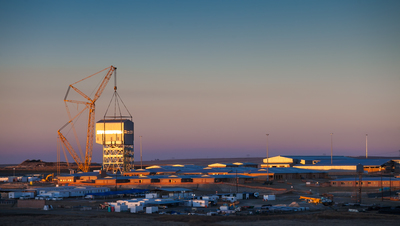
Contact Details:
WorleyParsons
39 Melrose Boulevard
Melrose Arch
Johannesburg
Gauteng
2076
South Africa
Tel: +27 11 218 3000
Fax: +27 11 218 3100
Send Enquiry | Company Information

EXTREME HOIST OF WINDER HOUSE GROUNDBREAKING POINT AT SHONDONI MINING PROJECT
Company News Monday, December 14, 2015: WorleyParsons
In January 2012 WorleyParsons RSA was awarded the engineering, procurement and construction management services (EPCM) contract for the Shondoni Mining Project, part of a R15,3-billion project undertaken by Sasol Mining to replace three of its ageing coal mines in the Secunda area. Upon completion of the upgrade, the three mines will be capable of supplying Sasol’s Synfuels complex with 42 million tonnes of coal per year, and transform the Secunda area into one of the largest underground coal complexes in the world.
The Shondoni Mine is a strategic project for Sasol, replacing the Middelbult Mine and protecting the baseline feed stock for the Coal-to-Liquids (CTL) operations within Sasol Synfuels. Construction on the Shondoni Mine began in May 2013 and is expected to be completed by late 2016. The new Shondoni underground facility will be a fully operational and functional coal mine, complete with all infrastructure, services and equipment, both surface and underground, to support 9.2 Mtpa of coal production, with an expected life of mine of 30 years.
WorleyParsons’ scope of work over the 45-month EPCM contract includes design through delivery of an incline conveyor shaft, an underground equalising surge facility, a man and material shaft complete with winders, a ventilation shaft with three 350 metre cubed per second main fans, and allowance for underground capital infrastructure to support the mine. Other major packages are the main surface civil infrastructure as well as an extensive materials handling system, which includes a 21 km overland conveyor.
Last week marked a critical and groundbreaking point in the project with the strategic and highly technical lift and positioning of the mine’s winder house taking place. Malcolm Bentley, WorleyParsons’ project area manager for the Shondoni Mining packages, says that what made this particular portion of the operation so unique is that the Koepe winders were installed into the winder house on the ground, concurrent with sinking and equipment activities on the main shaft. This is something that has not happened before on any similar projects or designs. The original schedule and methodology allowed for the winder house to be lifted in two parts onto the top of the headgear, followed by the winder installation, which takes several months. Lifting the winder house as a fully installed unit, as opposed to moving it in two parts and only then installing the winders as is the norm, will recover at least three months of time that has been lost during the sinking of the main and decline shafts, which was mostly due to ground water challenges and poor ground conditions.
The lifting and mounting of the winder house was a crucial stage in the surface infrastructure development that required intricate planning due to the high risk implications associated with this extreme hoist and the level of accuracy needed to align the winder house onto the existing headgear.
The massive winder house, including rigging, weighing 291 tonnes, was moved by crane across 58 metres and hoisted to a height of over 30 metres before finally being positioned on top of the headgear. Sarens, a world-wide leader in heavy lifting and engineering transport, undertook the lifting operations of the winder house.
Bentley says that while heavier crane lifts have been successfully achieved in South Africa, what made this process different and highly challenging is the size of the winder house, making it highly vulnerable to climatic conditions.
“It was vital that there was minimal wind on the day of the hoist; moderate to strong winds could have created a force on the building, placing the lift at risk,” explains Bentley. Advanced weather forecasting technology was used and all risks identified and mitigated.
The hoisting and positioning of the winder house began early in the morning on Saturday 01 August, and took just an hour and a half from start of lift to commissioning position.
Bentley goes on to explain that once successfully positioned, the winder house was precisely surveyed before hydraulic rams were used to micro-shift the headgear around until the winders were perfectly aligned with the shaft, and finally the unit was fastened to the headgear by the following day.
The winder house is expected to be fully licenced and operational in early November with the completed 11.7 metre diameter main shaft system fully operational in January 2016, reaching a total shaft depth of 155 metres. The shaft conveyance will be licenced to hold up to 200 people and carry a load of up to 65 tonnes.
